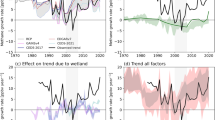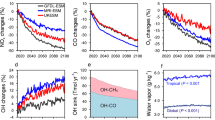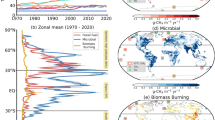Abstract
After methane, ethane is the most abundant hydrocarbon in the remote atmosphere. It is a precursor to tropospheric ozone and it influences the atmosphere’s oxidative capacity through its reaction with the hydroxyl radical, ethane’s primary atmospheric sink1,2,3. Here we present the longest continuous record of global atmospheric ethane levels. We show that global ethane emission rates decreased from 14.3 to 11.3 teragrams per year, or by 21 per cent, from 1984 to 2010. We attribute this to decreasing fugitive emissions from ethane’s fossil fuel source—most probably decreased venting and flaring of natural gas in oil fields—rather than a decline in its other major sources, biofuel use and biomass burning. Ethane’s major emission sources are shared with methane, and recent studies have disagreed on whether reduced fossil fuel or microbial emissions have caused methane’s atmospheric growth rate to slow4,5. Our findings suggest that reduced fugitive fossil fuel emissions account for at least 10–21 teragrams per year (30–70 per cent) of the decrease in methane’s global emissions, significantly contributing to methane’s slowing atmospheric growth rate since the mid-1980s.
This is a preview of subscription content, access via your institution
Access options
Subscribe to this journal
Receive 51 print issues and online access
$199.00 per year
only $3.90 per issue
Buy this article
- Purchase on Springer Link
- Instant access to full article PDF
Prices may be subject to local taxes which are calculated during checkout




Similar content being viewed by others
References
Rudolph, J. The tropospheric distribution and budget of ethane. J. Geophys. Res. 100 (D6). 11369–11381 (1995)
Gupta, M. L., Cicerone, R. J., Blake, D. R., Rowland, F. S. & Isaksen, I. S. A. Global atmospheric distributions and source strengths of light hydrocarbons and tetrachloroethene. J. Geophys. Res. 103 (D28). 28219–28235 (1998)
Pozzer, A. et al. Observed and simulated global distribution and budget of atmospheric C2-C5 alkanes. Atmos. Chem. Phys. 10, 4403–4422 (2010)
Aydin, M. et al. Recent decreases in fossil-fuel emissions of ethane and methane derived from firn air. Nature 476, 198–201 (2011)
Kai, F. M., Tyler, S. C., Randerson, J. T. & Blake, D. R. Reduced methane growth rate explained by decreased Northern Hemisphere microbial sources. Nature 476, 194–197 (2011)
Stein, O. & Rudolph, J. Modeling and interpretation of stable carbon isotope ratios of ethane in global chemical transport models. J. Geophys. Res. 112, D14308 (2007)
Xiao, Y. et al. Global budget of ethane and regional constraints on U.S. sources. J. Geophys. Res. 113, D21306 (2008)
Etiope, G. & Ciccioli, P. Earth’s degassing: a missing ethane and propane source. Science 323, 478 (2009)
Blake, D. R. & Rowland, F. S. Global atmospheric concentrations and source strengths of ethane. Nature 321, 231–233 (1986)
Simpson, I. J., Rowland, F. S., Meinardi, S. & Blake, D. R. Influence of biomass burning during recent fluctuations in the slow growth of global tropospheric methane. Geophys. Res. Lett. 33, L22808 (2006)
Rinsland, C. P. et al. Multiyear infrared solar spectroscopic measurements of HCN, CO, C2H6, and C2H2 tropospheric columns above Lauder, New Zealand (45°S latitude). J. Geophys. Res. 107 (D14). 4185 (2002)
Montzka, S. A. et al. Small interannual variability of global atmospheric hydroxyl. Science 331, 67–69 (2011)
Elvidge, C. D. et al. A fifteen year record of global natural gas flaring derived from satellite data. Energies 2, 595–622 (2009)
Johnson, M. R. & Coderre, A. R. An analysis of flaring and venting activity in the Alberta upstream oil and gas industry. J. Air Waste Manage. Assoc. 61, 190–200 (2011)
Stern, D. I. & Kaufmann, R. K. Estimates of global anthropogenic methane emissions 1860–1993. Chemosphere 33, 159–176 (1996)
Dlugokencky, E. J. et al. Atmospheric methane levels off: temporary pause or a new steady-state? Geophys. Res. Lett. 30, 1992 (2003)
Katzenstein, A. S., Doezema, L. A., Simpson, I. J., Blake, D. R. & Rowland, F. S. Extensive regional atmospheric hydrocarbon pollution in the southwestern United States. Proc. Natl Acad. Sci. USA 100, 11975–11979 (2003)
Jones, V. T., Matthews, M. D. & Richers, D. M. Light hydrocarbons for petroleum and gas prospecting. In Geochemical Remote Sensing of the Sub-Surface Vol. 7 Handbook of Exploration Geochemistry (eds Govett, G. J. S. & Hale, M. ) 133–211 (Elsevier, 2000)
Bousquet, P. et al. Contribution of anthropogenic and natural sources to atmospheric methane variability. Nature 443, 439–443 (2006)
Levin, I. et al. No inter-hemispheric δ13CH4 trend observed. Nature 486, E3–E4 (2012)
Schultz, M. G. et al. Global wildland fire emissions from 1960 to 2000. Glob. Biogeochem. Cycles 22, GB2002 (2008)
van der Werf, G. R. et al. Global fire emissions and the contribution of deforestation, savanna, forest, agricultural, and peat fires (1997–2009). Atmos. Chem. Phys. 10, 11707–11735 (2010)
Wiedinmyer, C. et al. The Fire INventory from NCAR (FINN): a high resolution global model to estimate the emissions from open burning. Geosci. Model Dev. 4, 625–641 (2011)
Fernandes, S. D., Trautmann, N. M., Streets, D. G., Roden, C. A. & Bond, T. C. Global biofuel use, 1850–2000. Glob. Biogeochem. Cycles 21, GB2019 (2007)
Strąpoć, D., Mastalerz, M., Eble, C. & Schimmelmann, A. Characterization of the origin of coalbed gases in southeastern Illinois Basin by compound-specific carbon and hydrogen stable isotope ratios. Org. Geochem. 38, 267–287 (2007)
Krol, M. C. et al. The two-way nested global chemistry-transport zoom model TM5: algorithm and applications. Atmos. Chem. Phys. 5, 417–432 (2005)
Spivakovsky, C. M. et al. Three dimensional climatological distribution of tropospheric OH: update and evaluation. J. Geophys. Res. 105 (D7). 8931–8980 (2000)
Sander, S. P. et al. Chemical kinetics and photochemical data for use in atmospheric studies. Evaluation No. 17, JPL Publication No. 10–6, http://jpldataeval.jpl.nasa.gov (Jet Propulsion Laboratory, 2011)
Andreae, M. O. & Merlet, P. Emission of trace gases and aerosols from biomass burning. Glob. Biogeochem. Cycles 15, 955–966 (2001)
Yevich, R. & Logan, J. A. An assessment of biofuel use and burning of agricultural waste in the developing world. Glob. Biogeochem. Cycles 17, 1095 (2003)
Acknowledgements
This research was funded by NASA (grant NAG5-8935), with contributions from the Gary Comer Abrupt Climate Change Fellowship. We acknowledge discussions with many colleagues, especially M. Aydin and C. Wiedinmyer. We thank colleagues at the Norfolk Island Bureau of Meteorology and the NOAA research stations in Samoa and Barrow for sample collection; the UCI team for sample collection and analysis, especially B. Chisholm, R. Day, G. Liu, B. Love and M. McEachern; and K. Masarie for work with the NOAA/INSTAAR data. M.P.S.A. is supported at JPL by an appointment to the NASA Postdoctoral Program, administered by Oak Ridge Associated Universities through a contract with NASA.
Author information
Authors and Affiliations
Contributions
I.J.S. was responsible for data quality assurance, global averaging and emission calculations and manuscript preparation. M.P.S.A. prepared the figures and improved the manuscript. S.M. was responsible for sample analysis and calibration, and data quality assurance. L.B. did the ethane modelling. N.J.B. improved the manuscript. D.H. made the NOAA/INSTAAR measurements and improved the manuscript. F.S.R. was responsible for study design and data quality assurance. D.R.B. was responsible for study design and data quality assurance, and improved the manuscript.
Corresponding author
Ethics declarations
Competing interests
The authors declare no competing financial interests.
Supplementary information
Supplementary Information
This file contains a Supplementary Discussion, Supplementary References, Supplementary Table 1 and Supplementary Figures 1-3. (PDF 1039 kb)
Rights and permissions
About this article
Cite this article
Simpson, I., Sulbaek Andersen, M., Meinardi, S. et al. Long-term decline of global atmospheric ethane concentrations and implications for methane. Nature 488, 490–494 (2012). https://doi.org/10.1038/nature11342
Received:
Accepted:
Published:
Issue Date:
DOI: https://doi.org/10.1038/nature11342
This article is cited by
-
Trends in atmospheric ethane
Climatic Change (2023)
-
A statistical analysis of time trends in atmospheric ethane
Climatic Change (2020)
-
On the Causes and Consequences of Recent Trends in Atmospheric Methane
Current Climate Change Reports (2019)
-
Discrepancy between simulated and observed ethane and propane levels explained by underestimated fossil emissions
Nature Geoscience (2018)
-
Atmospheric oxygen regulation at low Proterozoic levels by incomplete oxidative weathering of sedimentary organic carbon
Nature Communications (2017)
Comments
By submitting a comment you agree to abide by our Terms and Community Guidelines. If you find something abusive or that does not comply with our terms or guidelines please flag it as inappropriate.



